
Kuznetsov porcelain
Kuznetsov Porcelain is the general name for porcelain and faience products produced by a network of factories belonging to the Kuznetsov family. The largest conglomerate of enterprises in Europe produced a vast quantity of tableware and decorative items, which became accessible to wide segments of the population. Kuznetsov Porcelain is well-known to collectors worldwide, representing a vibrant chapter in the history of Russian applied arts. Starting from the second half of the 20th century, the popularity of this antique porcelain has been steadily growing.
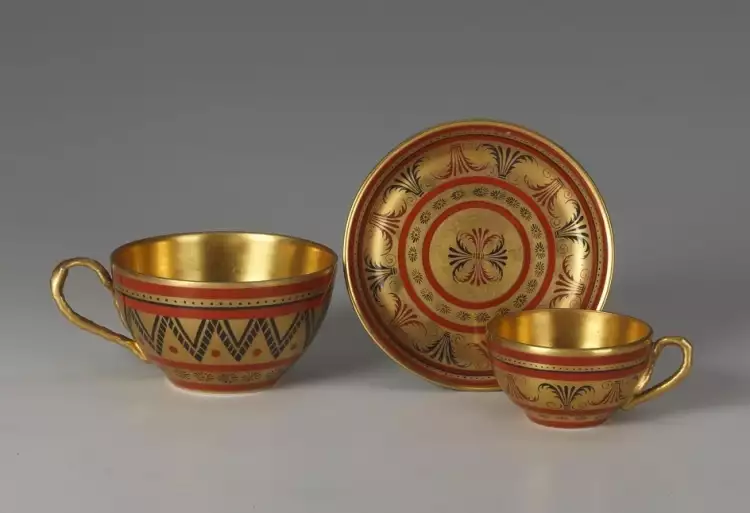 Kuznetsov porcelain. Cup and saucer. Factory in Dulevo, 1890s-1910s
Kuznetsov porcelain. Cup and saucer. Factory in Dulevo, 1890s-1910s
The History of Kuznetsov Porcelain: Its Origins and Development
The history of Kuznetsov Porcelain dates back to 1832 when a factory in Dulevo began its operations. However, twenty years earlier, Yakov Kuznetsov organized the production of faience in Gzhel. His son Terenty found a suitable location for a new enterprise. The vicinity of Dulevo had abundant forests and swamps that provided wood and peat for the kilns. The local population traditionally earned their living through crafts since the agricultural conditions were unfavorable, so there was no shortage of workers. In 1841, Terenty's son Sidor opened a factory in Riga. The family business gradually expanded through the construction and acquisition of the facilities of bankrupt competitors.
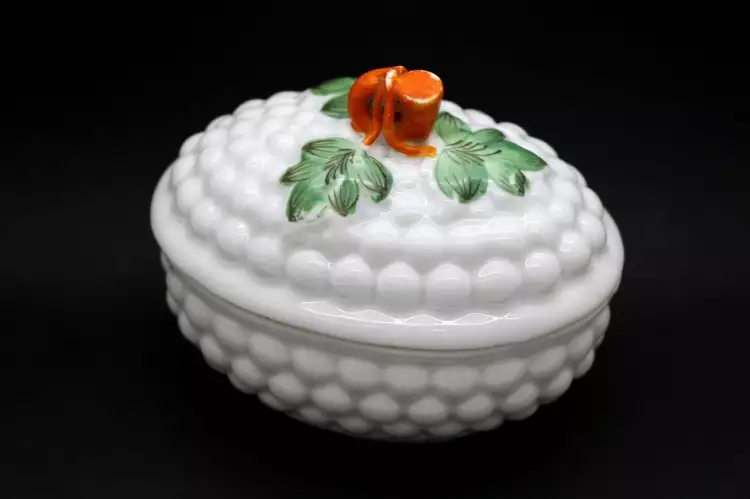 Kuznetsov porcelain. Porcelain box. Kuznetsov's factory in Riga, late 19th century
Kuznetsov porcelain. Porcelain box. Kuznetsov's factory in Riga, late 19th century
Kuznetsov Porcelain reached its peak under Matvey Sidorovich Kuznetsov, who was the sole heir of his father. From a young age, he was prepared for the future management of the family business: as a teenager, he worked at the Riga factory and knew the intricacies of all the processes, and his education at a commercial school developed his business acumen.
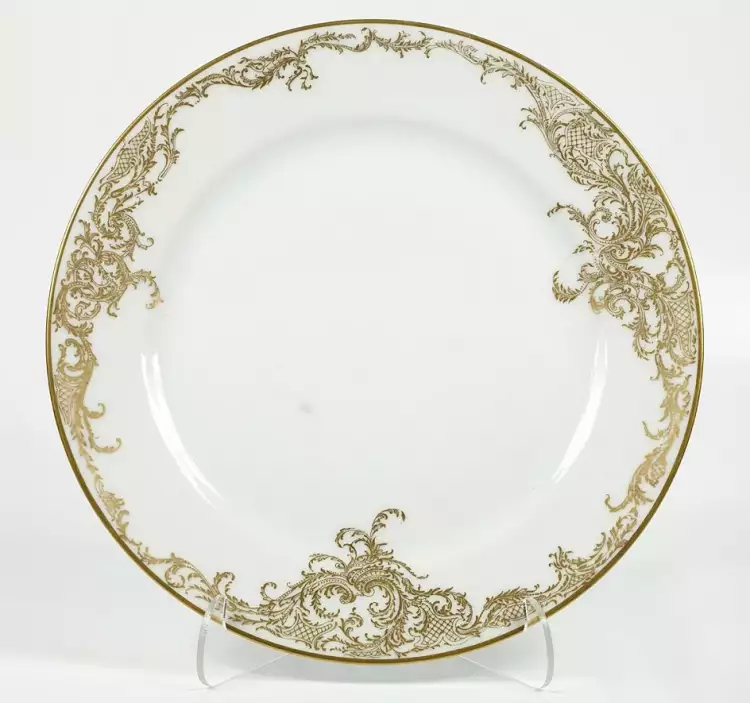 Kuznetsov porcelain. Plate with gilt ornament, late 19th century
Kuznetsov porcelain. Plate with gilt ornament, late 19th century
In 1887, the "Society for the Production of Porcelain, Faience, and Majolica Products of M. S. Kuznetsov" was founded. In its later stages, it included eight enterprises, contributing two-thirds of the revenue of the entire porcelain and faience industry in Russia. Some of the funds were spent on improving the living conditions: houses were built for the workers, schools for their children, and churches. At the turn of the century, the Society received awards at international exhibitions in Europe and earned the status of a supplier to the imperial court.
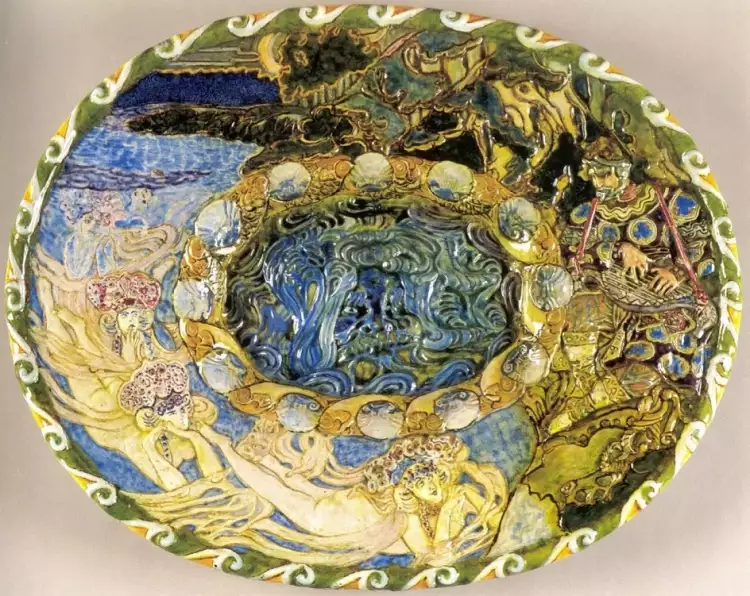 Kuznetsov porcelain. Decorative plate Sadko, 1900
Kuznetsov porcelain. Decorative plate Sadko, 1900
Matvey Kuznetsov passed away in 1911, and the enterprises were nationalized after the October Revolution. The descendants managed to temporarily preserve only the Riga factory, but it was also confiscated in 1940. Matvey Kuznetsov's grandson was executed, some relatives were exiled to Siberia, and others stayed in Riga and eventually moved to Europe. The factories continued to operate under Soviet rule, expanding their product range to include agitational and avant-garde porcelain. The technical equipment was so advanced that it did not require modernization until the 1930s.
Factories and Plants of the Kuznetsov Society
- Dulevo Factory (1832). Mass production of porcelain for Russia and the Middle Eastern countries. It produced tableware, vases, and figurines with distinctive bright decor.
- Riga Factory (1841). Initially founded as a branch of the Dulevo Factory and operated until the 2000s. The products made there hold high collector's value.
- Auerbach Factory (1829). Purchased by Matvey Kuznetsov in 1870. Over time, it was renamed the Tver Factory. It produced a wide range of products, from dinner services and individual serving items to interior decorations, fireplaces, and iconostases. In Soviet times, it was renamed the Konakovo Faience Plant, which has since gone bankrupt.
- Budyan Factory (1887). Produced affordable but high-quality faience tableware and decorative ceramics. It was destroyed during World War II but fully restored and operated until 2005.
- Gardner Factory (1766). Acquired in 1892, it was a renowned enterprise specializing in producing high-quality artistic pieces. It is now called "Verbilki Porcelain."
- Slavyansk Factory (1892). It was part of the Society until 1915 and produced faience, which is relatively rare today.
- Pesochnoye Village Factory and Plant (1884). Acquired in 1894, their main focus was production for Eastern countries. The primary enterprise was renamed the Pervomaysk Porcelain Plant, which ceased operations in 2012. The second factory produced crystal tableware.
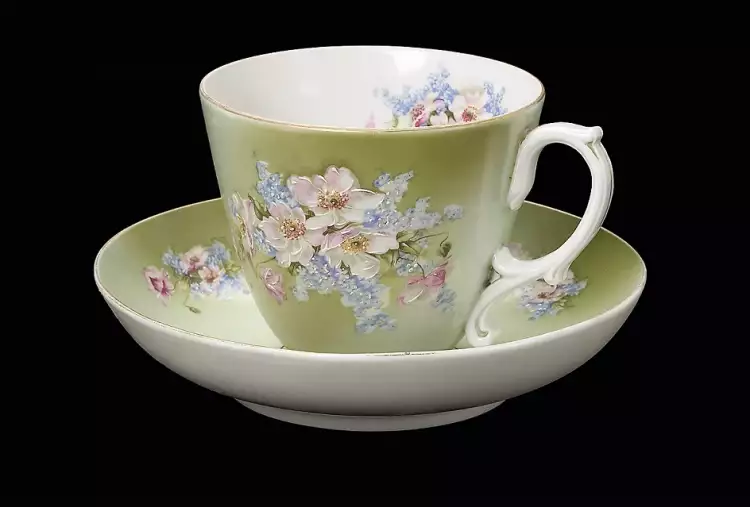 Kuznetsov porcelain. Souvenir cup and saucer. Kuznetsov factory in Tver, 1900
Kuznetsov porcelain. Souvenir cup and saucer. Kuznetsov factory in Tver, 1900
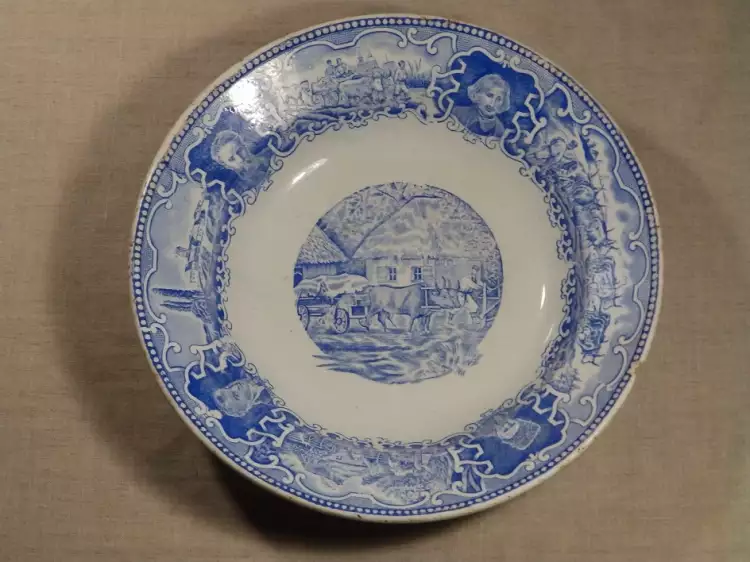 Kuznetsov porcelain. A porcelain plate. Kuznetsov factory in Budy, late 19th century
Kuznetsov porcelain. A porcelain plate. Kuznetsov factory in Budy, late 19th century
Kuznetsov Porcelain Marks
The marks of the Kuznetsov Society were numerous and diverse. After acquiring another enterprise, in order not to lose its customers and reputation, they continued to use the previous marks. Their own marks usually took the form of a circle or a vignette. They were impressed into the raw mass and outlined in blue or green color. The marks of the following factories are especially common:
- Dulevo Factory. Initially, the marks were applied in cobalt, later in blue paint over the glaze. For Asian products, an Arabic signature was added.
- Riga Factory. The marks are characterized by great diversity, but they almost always consist of complex images with many details and ornate borders. They were applied using overglaze blue paint.
- Auerbach Factory. After 1887, the inscription "Tovarishchestva M. S. Kuznetsova v Tveri" was used.
- Budyan Factory. The mark was applied using overglaze methods, and green paint was used.
- Gardner Factory. The famous red Gardner mark was retained along with their assortment.
- In the later period, marks were often applied without specifying the specific place of production. Abbreviations like "T. Ф." and "Р. Ф." were frequently used.
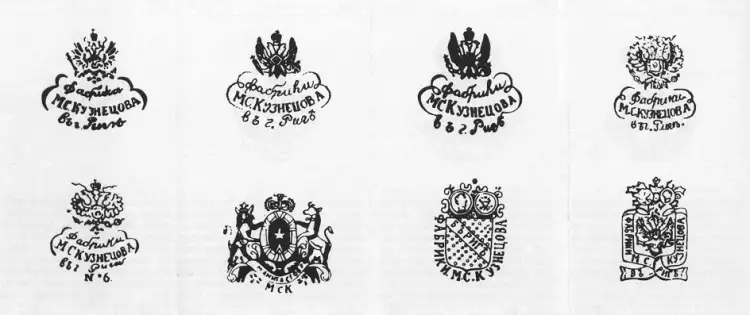 Kuznetsov porcelain. Labels of the factory in Riga
Kuznetsov porcelain. Labels of the factory in Riga
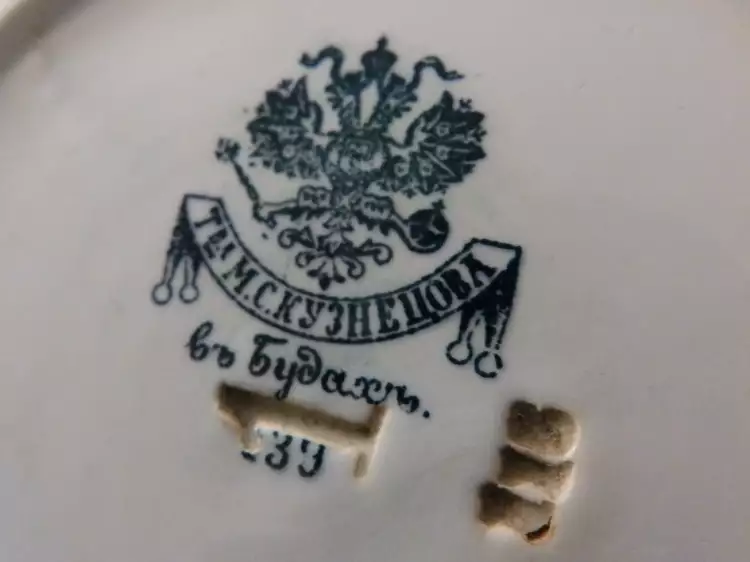 Kuznetsov porcelain. The stamp of the Budy factory
Kuznetsov porcelain. The stamp of the Budy factory
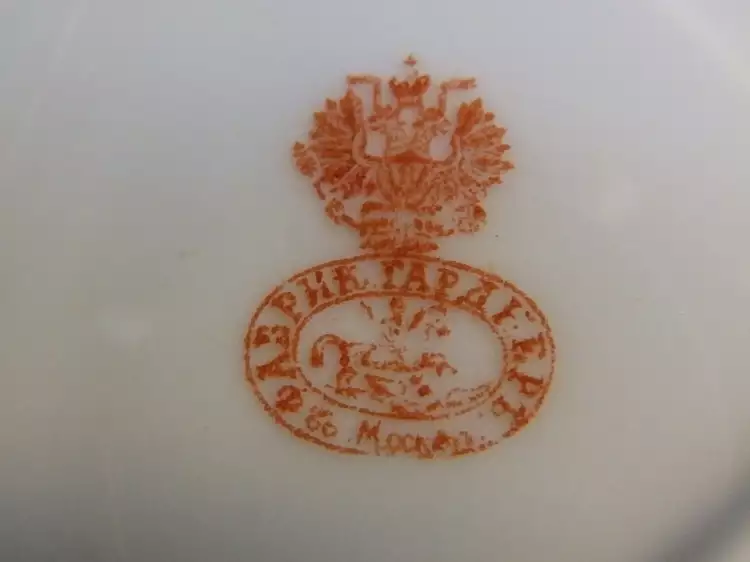 Kuznetsov porcelain. Gardner factory stamp
Kuznetsov porcelain. Gardner factory stamp
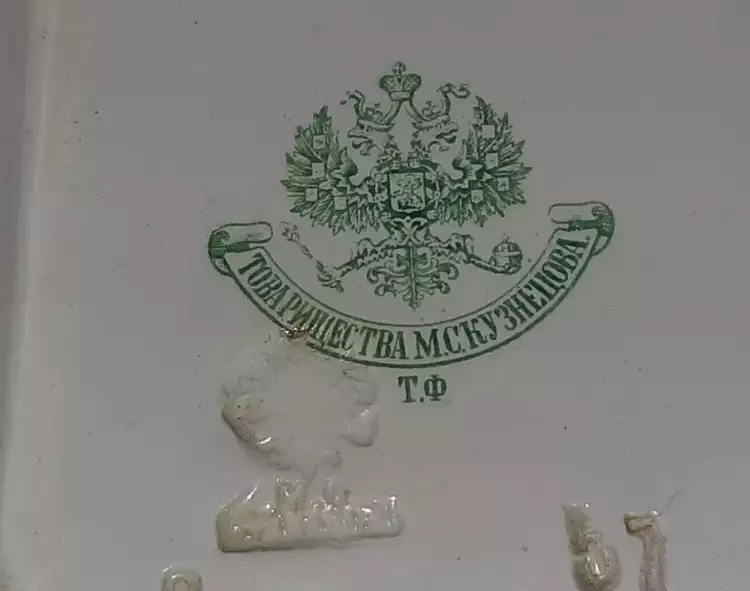 Kuznetsov porcelain. The stamp of the Kuznetsov Company
Kuznetsov porcelain. The stamp of the Kuznetsov Company
Buying Kuznetsov Porcelain: Where to Find Antique Items?
Collectors began taking a serious interest in buying Kuznetsov porcelain starting in the 1970s when its historical value increased. One of the advantages of Kuznetsov items is the vast selection and a wide range of prices. Suitable items can be found even under budget constraints or for a narrowly themed collection. There is no doubt that buying Kuznetsov porcelain is a profitable investment, as its value will only increase over time.
 Kuznetsov porcelain. Figurine Peasants. Kuznetsov factory in Tver, 1889
Kuznetsov porcelain. Figurine Peasants. Kuznetsov factory in Tver, 1889
The Very Important Lot website provides the opportunity to purchase antique and contemporary works of art without leaving your home: in the catalogs, you can find interesting specimens with photos and descriptions of their characteristics. Some of them are available for purchase at any time, while others are sold at auctions.
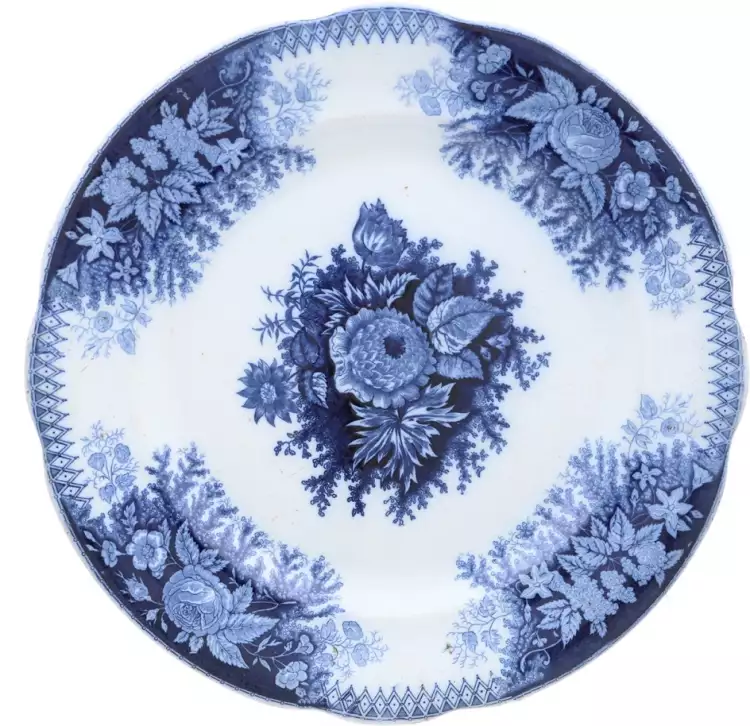 Kuznetsov porcelain. Earthenware plate. Kuznetsov factory in Tver, 1872-1889
Kuznetsov porcelain. Earthenware plate. Kuznetsov factory in Tver, 1872-1889
The Very Important Lot portal is a convenient platform for connecting sellers and buyers with a rich selection of products and reasonable prices. Don't miss the auctions regularly held on the site and enrich your collections with valuable finds!
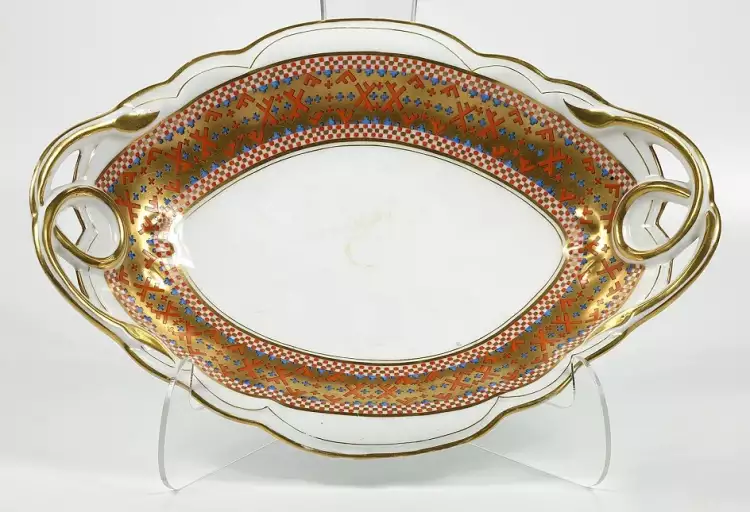
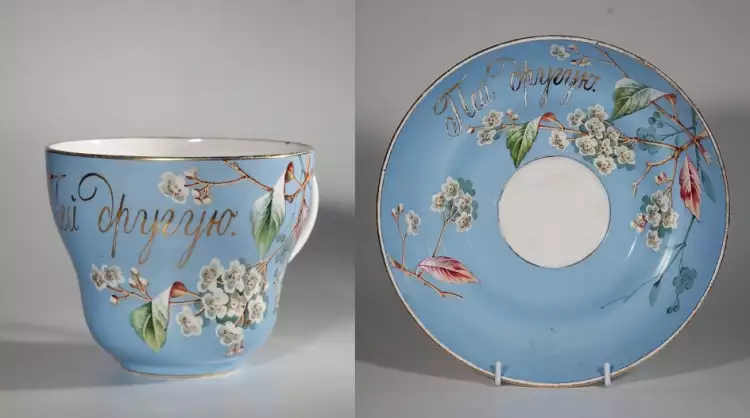
 Grisaille is a unique monochromatic art with stunning possibilities
Grisaille is a unique monochromatic art with stunning possibilities  Symbolism: the essence of the term, history in painting, distinctive features, famous symbolists
Symbolism: the essence of the term, history in painting, distinctive features, famous symbolists  Neoclassicism: once again, an alignment with ancient ideals!
Neoclassicism: once again, an alignment with ancient ideals!  Photography is an art accessible to everyone
Photography is an art accessible to everyone  Sculpture "The Pietà" by Michelangelo Buonarroti is a iconic work in Catholicism
Sculpture "The Pietà" by Michelangelo Buonarroti is a iconic work in Catholicism  An entangled world Willi Geiger
An entangled world Willi Geiger  Innovative Skyscrapers Reshaping Urban Skylines
Innovative Skyscrapers Reshaping Urban Skylines  The painting "The Jewish Bride" by Rembrandt is one of the master's last works
The painting "The Jewish Bride" by Rembrandt is one of the master's last works  Navigating the Currents: The Tension Between Vintage and Modern Watches
Navigating the Currents: The Tension Between Vintage and Modern Watches  Pablo Picasso was a recognized genius of 20th-century art
Pablo Picasso was a recognized genius of 20th-century art